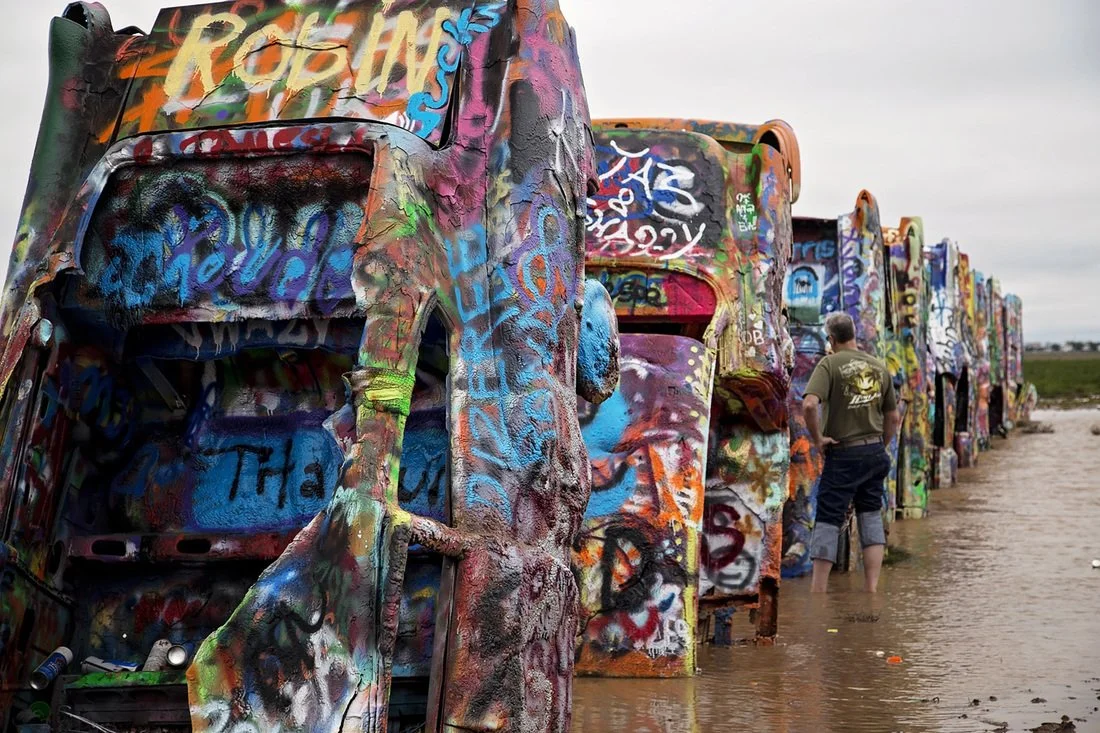Route 66 Legacy
Original post | 2015
Route 66 was born of necessity in 1926. From the wagon trails to the route of refugees fleeing the Dust Bowl to the people in search of adventure. As the country changed, the people changed. People became richer and fell in love with cars. Entrepreneurs followed along this route, for the possibilities to make money were endless. Gimmicks were as large as the dinosaurs and snakes themselves. Today, I-40 has taken Route 66's place; the old road is still there, but in parts and pieces. Some stretches are old and unnavigable; some portions are on private land. But the parts that remain remind us of an earlier time, a different era, when falling in love with travel and the automobile were as natural as breathing. Travelers couldn't wait to see what was around the next bend of the road. Brilliant neon signs beckoned them to "Stop here! Stay here! Shop here!" Motels lured them by outlandish design to stay the night (Have you slept in a wigwam lately?). Service stations offered both service and hospitality. Diners catered to the needs of families who had been on the road a little too long. There are remnants of another time when travel breathed glitz and glamour; it was a time when taking to the open road actually meant something - freedom, adventure, serenity. I like to think that as we travel this route, that I'm traveling the same road as many of my relatives did back in the 50s when getting away was something that was planned for all year, and as the departure date grew closer, anticipation evolved into a giddy gasp. Ah, the road trip. It's making a come-back, for we were not the only ones stopping at a moment's notice to photograph an old service station or detour down a dirt road. We saw many of the same cars and people along this 1,400 mile trek. History is making a come back.
Williams | Grand Canyon | Arizona
There's no better way to be escorted into the Grand Canyon than by rail; the Grand Canyon Railway offers vintage coaches and service with a smile. The tiny town of Williams' main attraction is the Railway and its GCR Hotel which made for a great jumping off point. One of the most impressive qualities about the hotel as well as its partners located at the South Rim of the canyon is their dedication to protecting the environment; from solar power to reducing water consumption to powering the steam locomotive with waste vegetable oil, they are protecting this place for my children. Riding the rail service keeps about 50,000 cars from entering the canyon yearly, reducing traffic and pollution. The ride to the canyon takes about two hours, and whether you ride coach or first class (we opted for a once-in-a-lifetime first class experience - well worth the cost for access to the observation dome and the observation deck), it's the perfect ride! Yes, there's the cheesy cowboys, but you easily fall in love with them, placing dollar bills inside your shirt hoping they'll rob you first. Book well in advance for day trips and hotel stays go quickly.
Flagstaff, Arizona
We spent about 6 hours in Flagstaff and only scratched the surface of what this modern western town has to offer. Flagstaff has its own stretch of the historic route winding through downtown and "the curve." On your way out of town, stop at Miz Zips (a Route 66 tradition) for great apple pie. Stay at Hotel Monte Vista for ghosts and cowboys; eat at The Place for great green chilli burritos.
Meteor Crater | Flagstaff, Arizona
About 35 miles east of Flagstaff, there's an unbroken plain stretched across the land. Approximately 50,000 years ago, a meteor plummeted to earth at the rate of 26,000 miles per hour. The result: a crater 700 feet deep and over 4,000 feet across. A 60-story building could rest on the crater floor. The Discovery Center contains its history, displays and the largest remnant of the meteor that still exists.There are self-guided tours as well as guided ones (app. 2 hours, 1 mile walk around the rim of the crater). I-40, exit 233. Open year-round.
Standing on a Corner | Winslow, Arizona
Thank you Don Henley and the Eagles for making the corner of Winslow, AZ, such a photo op. There's other iconic stops in Winslow, like the restored La Posada Hotel built in 1928. There's also the Falcon Restaurant on Berry St. which still serves. Winslow is on the original Historic 66 route.
El Rancho Motel | Gallup, New Mexico
As we head east, we cross into New Mexico and spend the night at El Rancho Motel/Hotel (M or H, according to which neon is shining at the moment). Its well preserved history (built in 1937) is a welcome sight to Route 66 followers, and if you're unsure whether you want to stay the night, you can always ask to see the room first - just like yesterday. Listed on the National Register of Historic Places, it is obvious upon entering that in its prime, it was magnificent, welcoming stars and guests, treating them all with 5-star service. Much like the Hotel Monte Vista in Flagstaff, El Rancho was the hub for stars during filming of westerns. We stayed on the second floor, which meant we either walked up the circular room-filling staircase or were escorted into the manual elevator and driven up by the bellman. We stayed in room 202, Alan Ladd's room. You can opt for Burt Lancaster, Fred MacMurry or Jane Wyman. Book early. Grab a great diner-style breakfast at Earl's Restaurant on your way out of town.
Grants, New Mexico
Uranium mining was big in this region, and you'll have a chance to go underground. Stop at Grants Chamber of Commerce and meet Jack Farley (below), a miner for some 43 years, and he will take you down below into the New Mexico Mining Museum. As a volunteer, he'll delight you with his mining stories of both coal and uranium, and he'll tell you he loved every minute in both. This replica of a uranium mine sits beneath the working chamber, and Jack explains that most mines range from 800 feet to 3200 feet deep. Local mining companies have donated all the artifacts in the museum, which makes this replica more impressive. Did you know the first use of uranium was by churches who used it in their stained glass windows? At one time, the government was the biggest purchaser in the production of nuclear bombs. Now, its for medical use, power plants and paint manufacturers. From room to room, he'll explain the work day, how the men gathered in the lunchroom and in the electric switch box, you could place 20 sandwiches and "microwave" a man's lunch. He'll describe how the earth feels when it moves around you. He'll also inspire you with his tales of playing 18-holes of golf daily, and how that and his time at the museum keep him moving. One of the most impressive tours we've joined. And when Jack gave Len and I a blue rock at the end, I dare to say, we almost cried.
It's the people that make places so extraordinary, and Grants has Jack. Don't miss this stop or El Cafecito for great food.
100 N. Iron Avenue, Grants, NM, $3 donation
Budville, New Mexico
The Budville Trading Company, built in 1928
Mountain Lodge | Carnuel, New Mexico
Just past Carnuel, the road sings. "To hear the song" put your right tire along the rumble strips and hear "America."
Blue Swallow Motel | Tucumcari, New Mexico | Circa 1940
Bent Door Cafe | Adrian, Texas
Cadillac Ranch | Amarillo, Texas
Bring your paint can and be part of the ages at Cadillac Ranch. It was built by a group of "art hippies imported from San Francisco" as some say. Their silent partner Amarillo billionaire Stanley Marsh wanted a piece of public art that would baffle the locals and be a tribute to the evolution of the Cadillac tail fin. Ten were driven there, then half-buried, nose down, facing west. From a 1949 Club Sedan to a 196 Sedan de Ville, they rise above the Texas panhandle. Today, it's a ritual for Route 66 followers to stop and spray paint your heart out. Take a picture, for your words will not be there long. I-40, exit 60
The Big Texan Steak Ranch | Amarillo, Texas
This legend opened in 1960 with the Big Texan neon lighting the way for weary travelers toward great steaks grilled over an open flame. It was in the mid-60s that the 72-ounce free steak to all who could eat began enticing thousands. Although today's steak ranch is not on the original Route 66, its original iconic cowboy still stands tall along I-40. Photo note: No, they did not finish the 72 ounces even though the crowd screamed them forward. Their bill was $72 each. The Big Texan Steak Ranch
Provine Service Station | Hydro, Oklahoma
This station was built in 1929 in response to the increasing traffic along Route 66. The second story was living quarters for operators. It became Lucille's in 1941, and she earned the nickname because of her good service as "Mother of the Mother Road."
Home of Mickey Mantle | Commerce, Oklahoma
There's a statue, the childhood home and the local high school baseball field that honors the legend of its hometown hero.
Munger Moss Motel | Lebanon, Missouri
It hails as home away from home for many Route 66 travelers. The Munger Moss Motel was built in 1946 and still has guests. They are proud that their neon has never been dark and with the help of the National Park Service Route 66 Corridor Preservation grant, it was refurbished in 2010.
And other points in-between . . .
Wagon Wheel Motel | Cuba, Missouri
World's Largest Rocking Chair | Fanning, Missouri
Walnut Canyon National Monument | Flagstaff, Arizona
TWIN ARROWS | FLAGSTAFF
Two Guns | Two Guns, AZ
Jack Rabbit Trading Post | Joseph City, AZ
Dot's Mini Musuem | Vega, TX
Largest Cross | Groom, Texas
WIGWAM MOTEL | HOLBROOK, ARIZONA | You can still sleep in a wigwam. Reservations requested.
Ranch House Cafe | Tucumcari, New Mexico
Vega Motel | Vega, Texas
Teepee Curios | Tucumcari, NM
Whiting Bros | Tucumcari, NM
Americana Motel | Tucumcari, NM
Magnolia Station | Vega, TX
Phillips 66 | McLean, TX
Britten Leaning Tower | Groom, Texas
Burma Shave | McLean, Texas
The sign series first appeared in Minneapolis, Minnesota, in 1925 and was a major advertising campaign. Typically, it was six consecutive small signs along the edge of highways, spaced perfectly for tourists. Over 600 sets of signs were placed from 1925 until 1963 and always ends with the iconic "Burma Shave."
The Rock Cafe | Stroud, OK
Marathon Station | Commerce, OK
Coleman Theatre | Miami, OK
Will Rogers Statue | Claremore, OK
Waylan's Ku-Ku burger | Miami, OK
Traveler’s Notes
Here it is! The Route 66 Map Series - maps of each state with descriptions of stops and historical information. Must have.
EZ 66 Guide - book written from east to west and from west to east. Extremely confusing, but offers useful anecdotal information. Use only as a secondary resource.
State maps - you can't navigate Route 66 without a up-to-date road map of each state. Contact each state's tourism department for travel information and a map will be included in the package you receive.






















































